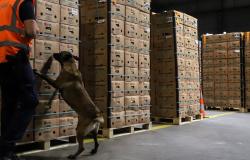In our British neighbours, the consumer organisation Ethical consumer
published a study on the environmental, animal and human impact of our clothes. heart issues, per- or polyfluorinated substances, known by the acronyms PFC or PFAS, used in our clothes, shoes and tentsand nicknamed “eternal pollutants”.
RECOMMENDED ARTICLE: Outdoor clothing (1/2): a British study evaluates the ethics of brands
© Nicolas Vaillant
Effective but dangerous chemicals
PFCs are a family of several thousand harmful industrial chemicals; they are designated as one of the six greenhouse gases under the Kyoto Protocol. Widely used since the 1950s, they have proven dangerous for your health (risk of cancer, disruption of the immune system, neurological system, fertility, etc.) and the environment (contamination of soil, water, disruption of ecosystems, etc.).
And yet, we find them everywhere, including, therefore, in our clothes. “More than 99% of people tested have PFCs in their blood,” writes Ethical consumer in his study; including babies from birth.
If PFCs are omnipresent in the mountain textile industry, it is because they are effective for waterproofing and wicking away perspiration in jackets, hiking shoes and tents. They are used in two main cases: either as a membrane which acts like a thin skin incorporated between the different layers of tissue; either as a coating or a finish that ensures water and dirt do not penetrate.
Most waterproof and breathable jackets contain a thin membrane made of PFTE (known as “Teflon”). However, the Gore-Tex brand has committed to eliminating what it calls “PFCs of Environmental Concern” (PTFE-EC) by the end of 2025, retaining the use of PFTE for the pro range. Indeed, this molecule is not strictly speaking considered “hazardous” because it is not likely to end up in the human body. On the other hand, it is during the production and incineration of clothing containing PFTE that this can be compromised, with a potential release of dangerous PFCs.
These products are also widely used for shoes when putting in place seams, laces, etc. Note that chemicals, if they are mainly released during the manufacturing process of the garment or material, are also released during their use or disposal.
Brands with more or less PFC
The study ofEthical consumer offers ratings on which brands use more or less PFCs, as well as some tips on caring for clothes that don’t contain them. Specifically, fabrics with PFC-free DWR coatings should be washed and re-waterproofed more often.
The result: very few companies are managing to break away from their reliance on these chemicals, and most are unclear about their use of PFCs. In total, out of 27 companies listed in the study, only 5 have stopped using them, including Fjällräven. Others have issued a target date for phasing out these uses: Patagonia aims to remove the 8% of PFCs it has left by 2025, the same for Vaude, whose tents contain only 12% of PFCs.
RECOMMENDED ARTICLE: Down jackets, shoes, hardshell jackets… how to choose eco-responsible ones?
Legislative path
In terms of regulation, a step was taken in January 2023 with a European bill proposed by five countries (Denmark, Germany, the Netherlands, Norway, Sweden) to ban more than 10,000 persistent chemicals. Shortly afterwards, an action plan on PFCs was launched in France, following which the National Assembly presented a bill to protect the population against the effects of PFCs last April.
It consists of banning, from January 2026, the manufacture, import and marketing of products containing PFCs in the cosmetics, wax, clothing and footwear sectors, particularly with regard to their waterproofing (except for firefighters and the military). On May 30, 2024, the Senate adopted the bill unanimously at first reading, with amendments. The second reading by the National Assembly remains, suspended following its recent dissolution.
Although the subject has begun to emerge, these “eternal pollutants” remain omnipresent in our lives and our environment.
RECOMMENDED ARTICLE: Ski wax’s ‘eternal pollutants’ are spreading on snowy slopes
Lagoped, the French example The French brand Lagoped, committed to the fight against the use of PFCs in the textile industry, offers the Sympatex membrane as an alternative. Made from polyetherester, this membrane appears to have equivalent performance to PFCs in terms of impermeability, breathability and sealing. These Sympatex-based products have the advantage of being fully recyclable and environmentally friendly. |







